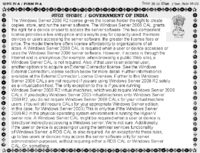UnNews:Microsoft admits: Nobody understands software licenses
22 April 2011
REDMOND, Washington - Microsoft CEO Steve Ballmer admitted yesterday that nobody within the company understands its software licenses.
In a surprise statement, Ballmer revealed that nobody actually understands those license conditions you find on virtually all software packs.
"We had long since realized that none of our legal team could offer any explanation as to what these licenses actually mean in human language" commented Ballmer, "but we had always assumed that there was a legal uber-eagle somewhere on campus who did understand them. Thus, we didn't worry too much."
A recent questionnaire of the Redmond legal department concerning the usage-rights of Windows Server had shown that from 250 lawyers who took part in the survey, 250 completely different opinions were submitted. This raised concerns that the originator of these licensing documents should be asked to come forward and explain what they actually mean. At that point the astonishing truth came out, which is that no such person exists. There is, in fact, no super-lawyer involved in their creation.
"I don't understand how SBS licensing works. From what I can find on Google and the MS Websites, neither does anyone else :)" commented Liam Black, head of the Microsoft Legal Division.
On enquiring where the license documents actually come from, a spokesperson for the legal department led Mr Ballmer to a somewhat outdated computer sitting in the corner of the office, attached to a dotmatrix printer. "Like all good software solutions, it's really very easy to use" he explained, "When the coding team turn-out a new product, we just enter the product name in this box, and press Enter. The licensing computer does the rest."
Examination of this computer, which dates from the early 90's, revealed that its core component depended on code produced during a brief venture into the field of AI, or artificial intelligence. The AI department, as it then was, had been tasked with writing software which would accurately simulate the responses of a human brain, thereby enabling computers to make decisions on their own inititative, even in unfamiliar situations.
Whilst the AI experiments had met with only moderate success, one interesting outcome was the finding that a simple change to one parameter would instead enable a computer to do the reverse, that is, to produce output which is totally opaque to the reasoning processes of the human brain. Furthermore, the algorithms involved in producing the output, owing to the reversal of the operating mode, would ensure that, to a high degree of certainty, no precise meaning of any kind could be ascribed to the machine's output.
At the time it was thought that this interesting but arcane programming quirk had no practical application, thus it was quickly forgotten. This made it all the more of a surprise to find the code still in active use in a production environment, decades later.
A closer inspection of the system indicated that licenses were in fact being created from a substantial database of legalese paragraphs. These paragraphs had evidently been culled from a number of sources, the most prominent being the licenses of early DOS or Windows 3.1 programs.The software would compile a new product-license by way of selecting and combining paragraphs which matched certain criteria in the name of the new product. The reverse-engineered AI component would then reorder and recombine these paragraphs as necessary to ensure that the resulting document could not be interpreted to have any fixed or definite meaning.
Commenting on these disclosures, Ballmer appeared surprisingly unconcerned. As he nonchalantly added, "Where copyright disputes are concerned, the actual law is of little relevance, the overriding factor in success being that of having the more expensive lawyer."
Update[edit | edit source]
In a further revelation, it has been discovered that the GNU Public License, so heavily favored by Linux coders, was created using a reverse-engineered copy of the Microsoft AI code. This discovery has been greeted with fury by Redmond, who have accused the open-source community of being "Bl**dy pirates!" Through a rare oversight the original AI code did not have any license document attached to it, so Microsoft are powerless to prevent its use in this manner.
It has similarly been disclosed that no open-source coder has yet been found who claims to understand the GPL. "We just add it to our T&C because it looks so cool" a Linux coder by the name of 'hQT33g&¬' remarked.
See Also[edit | edit source]
IIS Forum - Licensing required for running an IIS based web server
Microsoft - Windows Server 2008 R2 Licensing Overview
Kudzu - Windows server licensing

